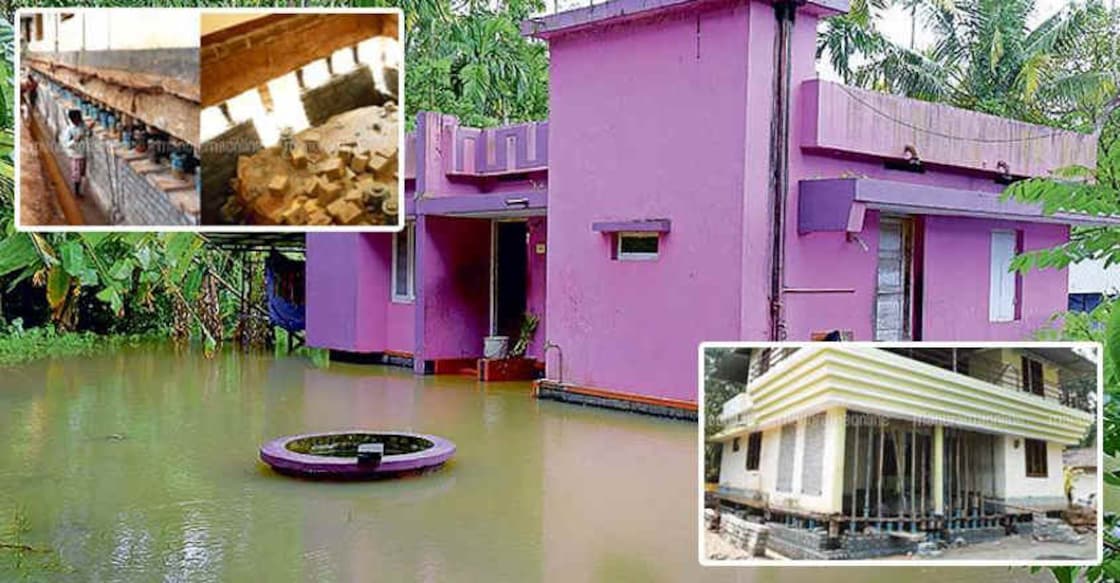The unique house-lifting technique to survive floods

Mail This Article
Post floods, one of the most speculated the ideas in Kerala is on building flood surviving houses. While reckless encroachment in ecologically sensitive areas and poor watershed management are larger issues that remain to be tackled, the state is actively looking at habitat management techniques.
Building stilt houses that stand on columns is a major flood resistant technique used in flood prone regions like the Brahmaputra valley in Assam, parts of Australia, Thailand and so on. Stilt houses allow the free flow of water with wall-free space below the ground.
Another technique that is already finding a lot of takers in Kerala is called house raising/lifting. The process of separating a building from its foundation and raising it above flood level seems to be a practical and cost-effective solution in flood prone areas.

Move it, raise it, turn it
House-raising is overhauling our concept of homes as fixed and immovable. Often employed in areas that are prone to flood and storm damage, this process is achieved through raising and supporting buildings using piles and then constructing a new foundation underneath. House-raising is also done to move and rotate the structure for aesthetic purposes.
Raised houses in Kerala to lead the way

House-raising is not an altogether alien idea in Kerala. In the past six years, around 50 houses – small and big – have been raised in Mepral, a low lying area that forms part of Upper Kuttanad. Raising the road level had caused rainwater gush to houses during the monsoon in Mepral Village. The region is prone to flooding and a lot of houses faced the danger of inundation almost every year.
Another issue that troubled the residents was the unstable soil which caused the foundations of structures to sink over time. Mepral residents found a viable solution to their problems by having their houses raised, some by a mere one foot and yet others by a whopping eight feet. Alappuzha, Kayamkulam and Kochi also boast of houses that stand tall in an all out effort to outdo floods.
The leviathan task safe in the hands of experts from Haryana
House-raising companies from Haryana have earned a name for themselves in the business. Expert engineers and workers carry out the job with precision and professionalism, say the house owners who have hired their services.
The intensive process would sound daunting, if not for the confidence of the Haryanvi experts. The actual lifting involves separating the structure from it’s foundation and raising it using hydraulic screw jacks. As the first step, a team of experts carry out a detailed inspection of the house. The age of the structure, the materials used for construction, the condition of the foundation and so on are assessed before a project is undertaken. The agreement between the individual and the company will specify the time and cost involved at each stage.

350 screw jacks and 40 workers
An average of 350 screw jacks will be required to lift a 1500sqft house. 30-40 experienced workers can finish raising a house of this size to the required height in about a month.
Though there are several piling systems available to elevate a structure, helical piles is the most cost-effective as it can be installed with a smaller crew. A trench of 2-3 feet depth is dug on both sides of the walls and piles are installed into stable bearing soils. The hydraulic jacks are then used to lift the house gradually. Depending on the condition of the structure it may be lifted rapidly or as little as fractions of an inch per day.
The ratio of 300 jacks to 30 workers is ideal for most buildings, say house-raising experts. 30 jacks, on which the weight of the structure is equally distributed, will be used at a time. A new concrete foundation is built underneath once the building is raised to a height of one foot. The rest of the work is completed with the jacks placed over this new foundation.
The level of the floor inside the house will be raised to match the height to which the structure is elevated. The electrical wiring and plumbing will stay intact when the house is raised. The water connection will be temporarily disconnected and can be restored after the work is completed.
Cost and time

House raising is a much cheaper option when compared to the cost of building a new house from the scratch.
» House-raising is priced at Rs 250 per square feet.
» A house can be raised within a period of one-and-a-half months.
» The flooring has to be changed after a house is raised.
» Wiring, plumbing, windows and doors will stay intact when a house is lifted and need not be redone.
House-lifting need not be a part of disaster management alone. It allows you a second chance to work at the aesthetics of your home, like turning the house around for better sunlight or view or even to place it in a more idyllic setting.

